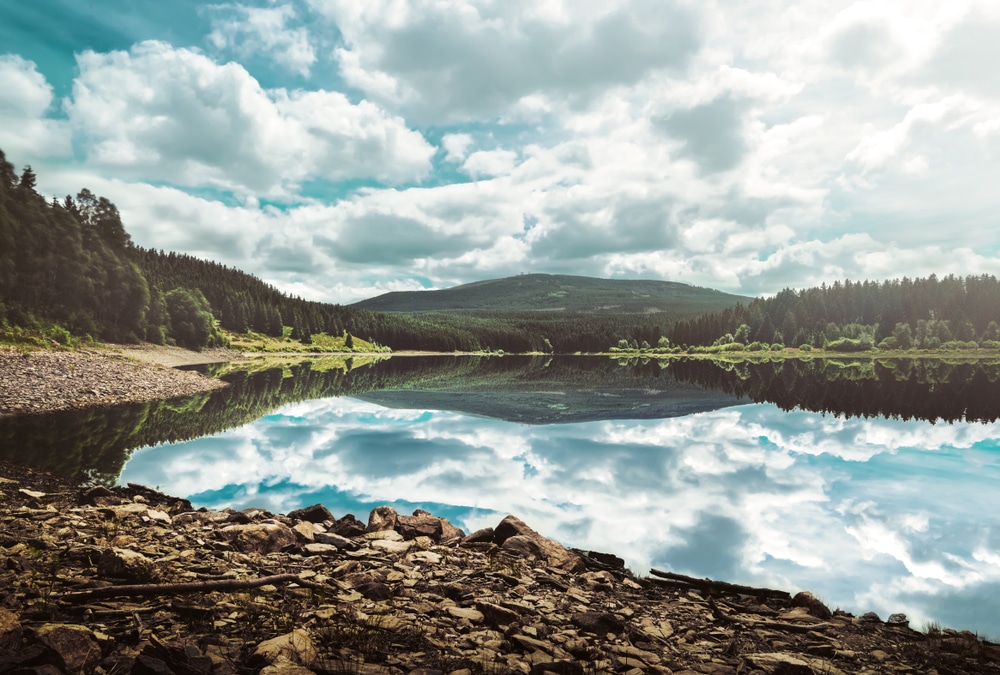The Harz Mountains are a low mountain range and include parts of Lower Saxony, Saxony-Anhalt and Thuringia. It is the highest mountain range in all of northern Germany. The Harz Mountains have a length of over 100 kilometers and a width of 30 to 40 kilometers. Over 8,000 kilometres of hiking trails and a number of sights attract countless tourists all year round. We have summarized some of the highlights.
The Brocken
At 1,141 metres above sea level, the Brocken, also known as the Blocksberg , is not only the highest mountain in the Harz Mountains, but also in the whole of northern Germany. It is one of the most popular excursion destinations in the Harz Mountains and attracts more than two million visitors every year.
There are many different hiking trails that lead to the highest point of the mountain, such as the well-known eight-kilometer Goetheweg. It got its name because it was once assumed that Johann Wolfgang von Goethe chose this route in 1777 for his ascent to the Brocken. The almost twelve-kilometre-long Heinrich Heine Trail was named after the well-known German poet who visited the Harz Mountains in 1824.
Visitors who are not quite so good on foot can also easily reach the summit of the Brocken with the Brocken cable car. The passenger trains are pulled up the mountain by historic steam locomotives in about an hour and 30 minutes.
In good weather, the visitor is rewarded with a breathtaking view over the impressive mountain landscape. On the summit is also the Brocken Museum, which brings the visitor closer to the history of the Brocken and its surroundings. The Brocken Garden, which has existed since 1890, is also worth a visit. On over 1,000 square meters there are over 1,500 plant species from all over the world that only grow in the high mountains.
Tip: If you have a smaller budget, renting a holiday home or apartment in the Harz Mountains is particularly recommended.
The Harz National Park
Another great destination for hiking in the great outdoors and wilderness is the Harz National Park. It is one of the largest forest national parks in the whole of Germany. In 2006, the national park in Saxony-Anhalt with an area of about 8,900 hectares and the Lower Saxony National Park with an area of about 15,800 hectares became the transnational Harz National Park with a total area of 24,700 hectares.
About 95 percent are overgrown with spruce and beech forests and more than 7,000 plant and animal species have become native to the national park. This is largely due to the fact that nature is still left to its own devices here. Over 600 kilometres of hiking trails offer visitors the opportunity to explore the great outdoors and, with a bit of luck, observe deer, deer, wild boar and raccoons in their wild. The black stork, woodpecker, kingfisher, boreal owl, pygmy owl and capercaillie have also been spotted many times. Visitors are somewhat less likely to see the raccoon dog and the European lynx, as these animals are considered extremely shy and therefore pose no danger to humans at all.
The European lynx was even considered almost extinct since the 19th century. After it was decided in 1999 to reintroduce the European lynx, around twenty lynxes were released into the wild in the national park between 2000 and 2004. As early as 2002, the park was able to look forward to the first proven offspring. The Harz National Park is now a UNESCO World Heritage Site.
The Sankt Andreasberg high ropes course
If you are also looking for adrenaline and adventure while hiking , the Sankt Andreasberg high ropes course is the place to be. With an area of over 6,000 square meters, more than 120 varied obstacles and over 100 stations in the great outdoors, the park is one of the largest high ropes courses in the whole of Germany.
The garden is suitable for beginners and advanced hikers, as the obstacles are freely selectable and have a height between 0.8 and 18 meters. It consists of nets, ropes, climbing walls, suspension bridges and beams. The visitor is secured twice or three times and trained specialist staff is available everywhere.
The absolute highlight of the park is the Flying Fox, a 300-metre-long zip line that whizzes down into the valley at high speed over the Help of God Pond.
The Hexentanzplatz Zoo in Thale
Fun for the whole family is offered by the zoo at Hexentanzplatz. It has been in existence since 1973 and offers a protected home to more than 70 species of animals and trees over 200 years old. Inhabitants such as otters, martens, peregrine falcons, kestrels, wild boars, red foxes, eagle owls, golden eagles and storks can be observed in the wild.
The special highlights of the park are the large and natural wildlife enclosures. On 5,200 square meters, the bears have enough space and can perform their usual activities such as climbing, digging and bathing. Visitors have the opportunity to observe the brown bears over a higher bridge. The wolf territory is located on an area of about 3,200 square meters. Visitors can overlook the entire complex from a suspension bridge. The lynx hill has an area of about 1,100 square meters and offers the lynx areas to hide and climb. The enclosure is separated by fences and glass walls and visitors can observe the animals at ground level.
The zoo also offers a 4,000-square-metre golf course with a total of 18 holes on two courses, each with nine holes. Particularly interesting for children is the petting enclosure with goats, sheep and rabbits.


